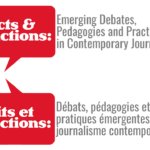A journalism professor learns multimedia one mistake at a time
By Meredith Levine
I am sitting in my office at Western University with my newly retired TV colleague Cliff Lonsdale, offering him some work.
Cliff is notably unexcited by my offer. I don’t blame him. I’m in a mess, a pickle, and I can only afford modest compensation for what is, in effect, a rescue mission.
About the rescue mission: I had shot several hours of video in Atlanta and Toronto for a multimedia project on chronic vertigo. I’ll get to the multimedia part in a minute. But first, let’s start with the video: Had I ever edited video? No. Had I ever directed video? No. Had I even worked in video? Well, yes, but the most recent project was 15 years ago, and my job then was to conduct interviews and write narration.
I had “B-roll” and action shots for scenes but I had been thinking in audio, my native journalistic tongue, while collecting the material. In audio, you don’t have to be so concerned with, for example, the idea that if someone is in a frame, they need to exit it before they suddenly turn up in a different location.
I clearly need help translating my “vision” into a series of workable video stories.
Cliff loudly exhales many times as he reviews the tape. Thankfully, he’s not one to back away from a challenge, and he’s a very supportive colleague.
It turns out to be a long, iterative process. Yet the more versions we cut—there were two features and three shorter video stories, plus five other clip selections—the more I learned from Cliff. My scripts became more visual and precise. I actually got the hang of video storytelling.
Video rescue mission completed. But this was a multimedia project, not a video project. It also included text, photos and at least one audio clip.
I had learned a lot about online journalism and the basic concepts of multimedia from Mary Sheppard, former executive producer of CBCNews.ca, when I had partnered with her in 2011 to produce with my journalism students, “A Good Death,” a 16-part multimedia series on the state of dying in Canada.
But for this project I was flying solo.
So what did I do? What every good academic does: I read up on multimedia and then discussed it with colleagues (including experts like Wayne MacPhail), I read some more, then discussed some more.
Yes, I was procrastinating, a tendency that plagues both journalists and academics, making me doubly prone. In the end, though, the distillation process proved helpful: I finally did understand a few more things about multimedia and got to work putting my chronic vertigo project together.
The biggest lesson I learned is this: multiplatform and multimedia are different beasts.
In multiplatform, the stories can ignore each other and just hang out on their own turf (platform). In multimedia, the stories need to be both independent and in dialogue—sort of like sovereignty association.
In multiplatform, it’s pretty much the same story across different media and platforms. In multimedia, each element is a unique story, one that is best told in its particular vernacular.
In multiplatform, repetition renders the whole as less than the sum of its parts. In multimedia, the collective narrative of the individual elements should yield a whole that is greater than the sum of its parts.
Here are some other lessons I learned:
Nonlinear story conceptualization—a key element of multimedia—is daunting, especially in the planning stages, and especially for those of us who came of age in a linear world. But choosing an anchor medium from the beginning and building in additional elements from there makes nonlinear planning and implementation much easier to conceptualize.
A very helpful, but somewhat arbitrary, way to figure out whether to allocate content to video or text is this: emotions = video while facts and explanation = text.
For example, in my series I tell the story of Janice Mackay, a Toronto woman who lives with chronic vertigo because of the side effects of the antibiotic gentamicin. Here’s the video story. And here’s the text story on gentamicin.
When working in multimedia, there’s the opportunity to use some visual effects to enhance the experience for the audience. That’s what we did for Janice’s video.
When working in multimedia, just because you can, doesn’t mean you should. Less can be more. With the encouragement of my friend and CBC video storyteller extraordinaire, Deborah Smith, I realized that one of my video stories was, in fact, much stronger as an online piece when I stripped its scenes and instead told the story with just on-camera interview clips from the main character and still photographs.
When things don’t work out as anticipated in multimedia (it’s inevitable that this will happen) it requires rethinking the master plan and the solution may come with reassigning a story to a different medium. For example, I thought that my rehabilitation story was a slam dunk as a video feature. It turns out I was wrong. The rehabilitation exercises were all so similar that it became repetitive after a while. Instead, the piece worked as a feature text and two shorter video stories, one from Atlanta and one from Toronto.
Just because “space” isn’t really an issue online doesn’t mean your multimedia project won’t get downsized, even if the content’s good. At most quality media outlets, content is edited. Yet in this era of downsized newsrooms, editors are a precious resource that need to be carefully allocated. Be prepared to say goodbye to elements you love. I did.
The most demanding lesson of all was this: first-rate multimedia work requires an intimate knowledge of the strengths and limitations of each medium.
As journalism educators rush to recreate our curricula to reflect the current platform-agnostic era in journalism production, it’s important to remember just how much work is required to master multimedia journalism, and how much editing too (for my text pieces, thanks go to Robert Sheppard and Paul Benedetti).
I’m far from a multimedia master but I think I have now progressed somewhere beyond the tadpole stage.
And in the end, I’m pretty proud of the work that is now mounted on CBCNews.ca. To see the whole project, check out: “Misunderstood and often misdiagnosed: the mystery that is vertigo.”




